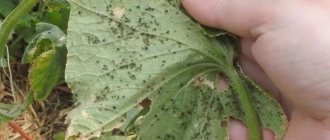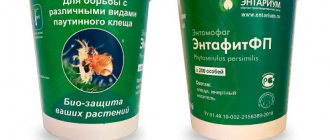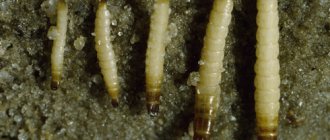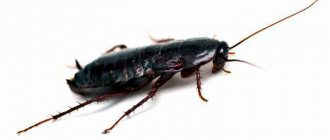Almost all gardeners are faced with such a pest as the slug. Due to its unpretentious diet, it causes great problems for growing useful crops, as it eats tubers, vegetables, fruits and young shoots.
Slugs require moist, cool temperatures to grow and reproduce. The cellar is an ideal place to live for these animals. It almost always contains vegetables and root crops for food, as well as high humidity and a constant microclimate suitable for slugs. Although they do not completely eat the fruits, by damaging the top layer, they contribute to their spoilage and can destroy the entire harvest. Therefore, at the first sign of appearance, you should apply all the necessary knowledge and remove them from the premises.
Get rid of slugs in your cellar
general information
If dampness appears in the cellar, increased humidity means that slugs will soon appear.
Especially on dark evenings and nights, and, of course, where there is a lot of food. As a rule, slugs find their way through cracks (if the cellar is not of very good quality) or through a choke. In addition, the temperature of +5°C is optimal for the appearance of shellfish, so it should be avoided by all possible means. Meanwhile, slugs may well be hiding in fresh vegetables even when they are placed in the cellar.
And the owners don’t even suspect that someone has settled in the cabbage leaves. But if slugs appear in the cellar, how can you still fight them?
How to get rid of slugs in the house
Estimate the size of the stretched out slug. And this is far from the largest specimen.
Did the slugs prevent me from admiring the flower? Well, so be it. I will admire the amazing creatures that managed to take over Europe. It turns out they are very, very interesting creatures.
And finally. How long have you seen a hedgehog on your summer cottage? Ah, a long time ago. And no hedgehog will get into your area, because you have a reliable fence, under which even a mouse will not slip. How long has it been since you removed all the moles? Ah, already a decade. And you don’t want to see any more such misfortune in your life. What do you do with a toad you accidentally see? Oh, you're doing the same thing. Dirty and disgusting... What if there is a snake? Oh, this is terrible horror...
Continue, dear summer residents, to clean out your plots in accordance with your pathetic illusions, as if you decide who lives here. The red slugs are on their way. Get ready to meet uninvited guests. And get ready to give them everything - vegetables from the garden, fruits from the garden, and even flowers from your favorite flower bed. Slugs love everything. They'll eat it all. Do you think some clever poison will help you? Imagine how much of this poison you and your children will eat and inhale. And think for a second that someone will come after the slugs. After all, someone will come. Necessarily. Are you ready for this meeting?
Photo and text: Lazy Summer Resident, 2014
Next page: Red slug. Gastropod close up
Types of slug control
The very first thing to do is to check all fresh vegetables before they are put into the cellar. Carefully, without damaging.
There are such types of struggle as:
- Chemicals - various preparations sold in garden stores and departments of hypermarkets. They are usually loose and dry. They need to be scattered on the floor, on shelves, and the corners must be carefully processed.
- Mechanical – use of traps, barriers.
How to protect cabbage and strawberries from slugs?
Slugs' favorite treats are strawberries and cabbage.
Gentle methods of control:
- collect in the morning;
- keep the garden clean;
- rotate vegetable crops in a timely manner;
- attract birds, hedgehogs, frogs, etc. to help.
Mechanical control:
- Place plastic or metal gutters around the perimeter and periodically fill with water.
- Sprinkle between rows: gravel, shells, eggshells, etc.
- Use special granular materials that are scattered around the plantings, and they, in turn, create a barrier.
- Buy plastic rims that are fixed in the ground.
- Install raised beds.
- Make traps.
- Purchase biological control products: powder containing the desired microorganisms is diluted with water and watered over the plantings.
- Apply phytocontrol: planting garlic, herbs, etc.
- Use folk remedies.
The main thing is, of course, prevention. Well, the last thing you need to use is poisoning with chemicals.
How to get rid of slugs on cabbage?
Cabbage is the most favorite delicacy of slugs. Early varieties suffer even when the first leaves are formed.
We start with the correct landing. Plant seedlings at a distance of 50 cm and no more. Such placement will not allow creating favorable conditions for living: shaded, dense, humid areas.
After planting, put a ring on each seedling:
It is more convenient to cut from a 2-liter bottle
The edges should have uneven jagged edges of varying lengths.
The seedlings are carefully threaded into the neck. The jagged edges will easily damage the slug's body if it decides to eat the cabbage.
When the head of cabbage begins to form, the lower leaves, especially those in contact with the ground, must be torn off.
A folk remedy has worked well: fresh wormwood leaves and whole nettles are placed around the cabbage, changing from time to time.
Get rid of it this way:
- water in the evening with water + 50°;
- Cabbage can easily withstand this temperature, but slugs cannot.
Spray with red hot pepper solution:
- grind 80–100 gr. pepper (in pods);
- soak in 1–1.5 liters of water;
- leave for 2–4 days;
- boil for 5–10 minutes;
- leave for 1–2 days.
Mode of application:
- 100 ml of infusion, diluted in 10 liters of water;
- rub some laundry soap there;
- Spray the cabbage.
Traditional methods and traps
The most painstaking trap involves laying linoleum or plywood on the floor. The material is not important, the main thing is that it is smooth and dry. Place the raw boxes on it and wait. Over time, the boxes will dry out, the humidity will decrease, and the slugs will begin to look for a cooler and damp place - on the floor under the flooring. All that remains is to raise the flooring and collect the pests.
Some summer residents actively use beer. The most common thing. It is enough to place a partial glass in the cellar overnight. In the morning, remove everything that is in it. The point is that the slugs will get into the glass, but they won’t be able to get out. It is recommended to refresh the beer once every three days.
An example of a working trap can be seen in the video below.
Seri says:
This has never happened before, but this spring the basement flooded. Oh, we hesitated with these slugs. Horribly disgusting. We placed rags in each corner, but we didn’t succeed the first time. I had to repeat the procedure a couple more times. But they return periodically. Trouble.
What types of slugs are there and what harm do they cause?
There are many types of slugs. Classification occurs according to the following parameters:
- To size. The length is very different, ranging from 2-300 millimeters. The largest is considered to be the black slug.
- Nutrition preferences. There are cabbage, grape and other types.
- By color. They are distinguished by light, spotted, black, versatile colors.
- By location. The most common are forest and garden, and in terms of geographical habitat - European. The latter species is harmful not only to vegetables and fruits, but can also be poisonous to other animals, as it carries parasites and is dangerous to the lives of pets.
Shellfish cause irreparable damage to vegetables and fruits destined for storage in the basement. When the required dryness is not ensured in the cellar, you will have to constantly fight slugs. They do not pose any hygienic harm, but spoiled products rot very quickly.
Slugs prefer grain crops most strongly. Less interesting are cucumbers, parsley, garlic and onions. The trace left when moving is also dangerous for plants. It contains microbes and bacteria that contribute to the growth of diseases in vegetable and fruit crops.
Powdering
Despite the fact that shellfish can and should be dealt with, collected, caught, it is equally important to treat the premises to prevent their reappearance. Usually lime or a mixture of chalk and wood ash is used for this.
It is necessary to remove all supplies of fresh food, canned food, items from the cellar and seal all cracks with cement. Then carry out dusting. Slugs quickly die from this. Afterwards, whitewash the walls, floor, and ceiling of the room with lime. Dry the cellar, ventilate it and you can bring the supplies back.
This method is most effective at the initial stage of the appearance of slugs, when there are still few of them.
Chemical destruction methods
The next method includes various types of cellar fumigation. The advantage of this method is that most slugs die in a short period of time. But there is also a negative point here. This kind of fumigation must be carried out carefully so as not to poison yourself and not to saturate food with smoke.
Types of sulfur beds.
One of the most successful methods of this type of control is fumigation with sulfur. First, remove all food supplies from the cellar. Even those that are in closed jars should be taken out. After this, tightly close all cracks, vents and hoods. Put on unnecessary clothing and a gas mask or gauze bandage. Now you can start fumigating. Try to fumigate every part of the cellar.
After this, you should leave the cellar completely closed for about a day, and then thoroughly ventilate everything for several days, open the hoods and vents, and also treat the walls, floors and ceiling with antiseptics. It is also advisable to wash and dry everything well, since you will have to remove the corpses of slugs in any case. And only then can you bring the products back.
Another method of combating slugs in basements and cellars is to chemically kill them with poisons. This method is much more effective than the previous one, but at the same time it is even more dangerous. In the form of poisons, the most effective are granules that are scattered on the floor of a previously emptied and sealed cellar.
The most effective poisons are ferric orthophosphate, croneton and metal hydride. These drugs are time-tested. The meaning of their action is that they turn shellfish into mucus. The granules can also be scattered on small plastic stands. This way you will have to clean up less mucus on the floor.
Due to the toxicity of the substances, after poisoning the slugs, it is necessary to thoroughly clean the cellar, treat it with antifungal compounds, and open all doors and vents. It needs to be ventilated for a relatively long time - at least a week. In this case, it all depends on the degree of toxicity indicated on the packaging.
Prevention
If the slugs have not yet appeared or have already been hatched, it is necessary to regularly “look after” the cellar so that the pests do not return. To do this you need:
- create good ventilation;
- ventilate regularly;
- at the first appearance, immediately seal all the cracks;
- In autumn and spring, sprinkle mineral fertilizers or salt inside along the walls and near the manhole. This will stop the shellfish like mothballs;
- check vegetables for contamination and colonization.
Anastasia says :
This summer it's easy to attack with a huge number of slugs in our cellar! I have never seen such a huge number of slugs in my life. At first they collected it manually, but an integrated approach to the fight is important. We tried many means to kill slugs, unfortunately, only chemicals helped, but now we can’t store vegetables, odors, secretions in the cellar for a long time, we couldn’t get rid of them using traditional methods.
Preventive measures against slugs
There is nothing better than prevention. How to deal with slugs? It is necessary to regularly dry the cellar, but use special treatment substances that help protect not only from slugs, but also from other parasites.
The most popular methods of prevention:
- place wet rags and collect animals crawling there;
- treat the walls and floor with a salt solution;
- sprinkle dry mustard;
- whitewash the walls and ceiling;
- Provide the cellar with good ventilation to reduce humidity.
To preserve food in the cellar, it is very important to know how to get rid of shellfish. Although they are not the most harmful parasites, under favorable conditions they can destroy the entire crop. The main thing is to keep the basement dry and remove slugs from the cellar in a timely manner.
Cellars Kuzmich
Slugs are a real disaster for the cellar and its supplies. And it doesn’t matter how it was created: brick or plastic. Dampness and humidity, cracks are the main reason for the appearance of guests. But at the same time, pests are not able to appear in Kuzmich’s monolithic cellars. Our cellars are made of hydroconcrete M-400/B20/W12 and have additional layers of waterproofing, so moisture from the outside simply cannot appear in the room.
In addition, the cellars already have properly functioning ventilation and a sealed hatch, thanks to which the air will be relatively dry. Interior decoration, carefully crafted corners and seams, a completely monolithic body - ideal protection against various kinds of pests, mold, mildew and other troubles that lie in wait for fresh vegetables in the cellar.
In addition to everything, we equip the Kuzmich cellars with shelves and racks, a ladder, and an LED lamp. This is a completely ready-to-use cellar, reliable and safe.
Methods for removing slugs
Having learned about the characteristics of these pests, you can proceed to their removal. Please note that the procedures described below are best carried out jointly with residents of neighboring areas. Quite often, slugs that disappear from one basement soon appear in the next one.
Fighting slugs in the cellar can be done in different ways. Among them: creating obstacles to prevent them from entering the premises, setting traps and using chemicals. Conventionally, all these methods can be divided into two categories - preventive and aimed at exterminating pests.
Creating barriers
Slugs have a very delicate body. They cannot climb over scratchy or burning obstacles. Ash, salt, lime or crushed shells are suitable for creating a barrier. Sprinkle them on all possible places of their penetration. You can also use commercial pest control products.
Obstacles must be laid in the form of a convex path. Do not forget to ensure that there are no holes in them for passage. This method gives excellent results, but is preventative, since the existing slugs will not go away.
Traps
Traps are an effective remedy against slugs and snails in the cellar. You can use ready-made tools or build a trap yourself.
The beer trap is very original and simple. Experience shows that it is best to use dark beer. Fill a low bowl ½ full with beer and empty it once every few days. The principle of its operation is very simple - attracted by the aroma of beer, the mollusks crawl into the bowl and drown.
If you approach the trap and notice a lot of live slugs next to it, collect them manually. Pests will die if you pour boiling water over them.
A bowl of dark beer is a great trap.
Chemicals
If the previous methods were not effective enough, use chemicals. These products should be used last, as they are not completely safe for human and animal health.
Purchase poison from a hardware store and use it strictly according to the instructions on the package. The drug must be spread on all horizontal surfaces - on the floor and on shelves.
Please note that most common insecticides do not have the desired effect on slugs. Look for so-called “molluscicides.” Basically, all such preparations contain copper sulfate.
If you are unable to find a suitable remedy, prepare it yourself. Combine equal parts of chalk powder and sulfur. Mix the mixture thoroughly and treat the walls with it. You will soon find that the slugs are immobilized. Just sweep them off the floor and pour boiling water over them.











